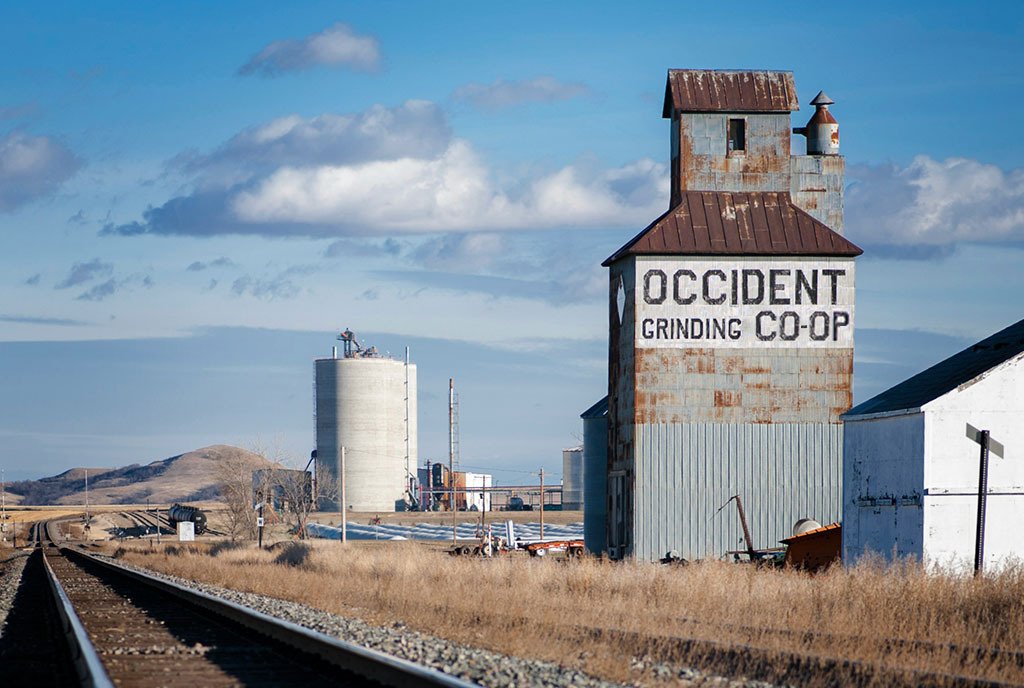
Travel across the United States today, and you’ll find in many small towns a towering grain elevator or a similar agricultural edifice looming over the rusty train tracks. Often, these structures bear the faded letters “CO-OP” painted on the side.
A century ago, these cooperatives enabled farmers to bargain collectively with bankers and railroad companies. These farmers also successfully advocated for a system of federally backed cooperative banks and joined together to form farmer-owned insurance pools, allowing agriculture cooperatives to form, including prominent brands like Land O’Lakes and Ocean Spray.
Decades of policy changes, however, often under the radar, today inhibit many diverse kinds of association.
[We need] the means to build associations that are powerful enough to successfully challenge the economic powers that be.
This must be rectified. Public policy needs to facilitate large-scale financing for mutualist enterprises—organizations like cooperatives, employee-ownership trusts, and mutual insurance companies. Doing so will help enable ordinary people to associate to solve their own problems, rather than depending on wealthy elites to do it for them.
Mutualism under Threat
Some of the most remarkable achievements in US history occurred when policy enabled people to come together powerfully. In the first half of the 20th century, the crisis of rural electrification ended when the government enabled neighbors to access loans for building their own electric co-ops.
Today, such collective efforts are often stymied. In many states, local communities are banned from establishing their own internet utilities, even when private providers fail to serve them. These restrictions are the result of policy shifts that have quietly undermined the right to associate
In principle, people in the United States have this right—Article 20 of the United Nations’ Universal Declaration of Human Rights asserts that all people should be able to freely form associations to meet their collective needs. What is lacking, too often, is what farmers a century ago fought for and gained—the means to build associations that are powerful enough to successfully challenge the economic powers that be.
Another way is still possible. A small change to employment law in 1974 enabled over 10 million workers to share in the profits of their employers. Even at a time of crippling political dysfunction, achieving these goals is surprisingly feasible.
Defining Mutualism: Association Let Loose
My introduction to mutualism came about after first meeting Sara Horowitz during a conference in New York where she spoke. For several years, I had been a grateful member of the Freelancers Union, which she founded in 1995. Before the Affordable Care Act, it was the only good option for health insurance. Through the organization, freelancers like me could band together and buy insurance at a group rate.
At the conference in Q and A period, I tried to provoke her. What was Freelancers Union doing for the most precarious workers, beyond its main constituency of educated professionals? Why should the organization focus on people like me, rather than on them?
She answered like she had heard the question 100 times before. She had no patience for my assumption that everyone with any bit of privilege should sacrifice on behalf of those with less. That’s charity, she said, and it is fleeting. Lasting change and lasting organizing happen, she said, when people find common cause. My self-righteous call-out got called out. I don’t recall if I could admit it at the time, but she was right.
Later on, in 2021, Horowitz published a book called Mutualism. On the first page, she puts the mutualist ethic this way: “We can look to one another to solve the most intractable problems we encounter in our lives.” Mutualism is the right to associate let loose in the economy.
Horowitz presents three distinguishing features of mutualist organizations:
- Social Purpose: Mutualist organizations prioritize a social purpose over profit.
- Economic Mechanism: They have an economic mechanism that ensures independence and self-sufficiency by offering something that people want and will pay to have.
- Long-Term Focus: They honor past traditions and plan ahead for future generations.
Mutualism does not happen in a vacuum. Mutualists do not expect governments to solve their problems for them, but Horowitz stresses that enabling public policy is necessary for mutualism to flourish.
Mutualism lets people meet their own needs, rather than waiting on wealthy investors.“To become a useful partner to mutualism,” she explains, “government must enshrine, protect, and grow the mutualist sector by building new kinds of capital markets.”
Often imperceptibly, policy shapes what does and doesn’t seem possible. It trains us to accept what we should not accept and to see as impossible what should, in fact, be our right.
Missing Markets
What does your community need but can’t seem to get? For example, a community can be full of talented, unemployed young people because nobody can afford to start a business there.
These are what economists call “market failures.” The co-op economist Brent Hueth has another way of thinking about these problems: they are “missing markets”—what we should have, but we don’t.
Mutualism lets people meet their own needs, rather than waiting on wealthy investors. Having the right to associate means that when people want to do something for their communities, they have the means to do it with mutualism.
What could this look like in practice? That will only become clear in the doing but here are a couple of hypothetical ways one could imagine this taking place.
Community-owned internet service: Consider a large, cooperatively owned mobile home park with affordable housing in a high-cost region. Broadband internet access is available through one of the national telecoms that serves the area, but connections are typically below the advertised speed and outages are frequent. Because the telecom has no competition, it has little incentive to improve service.
Through conversations at the local playground, residents decide to create their own internet service provider. They secure a small grant for a feasibility study from a nonprofit and, maybe a year later, obtain a loan from a local credit union to establish a customer-owned cooperative. Not every resident enrolls, but most do, and that is enough to hire and train one of the residents as a technician to operate the system. By tapping into a city-operated fiber-optic “backbone,” the community has access to high-speed internet service.
This scenario is reminiscent of how the Rural Electrification Act of 1936 enabled rural communities to develop cooperatively owned power systems through affordable loans and grants. But that policy is too often inadequate for people’s needs today.
Union-owned renewable energy: Imagine a largely immigrant neighborhood near an oil refinery. Many residents work in the energy industry, and large portions of their incomes go back to that industry. At union meetings, some of these workers begin discussing plans to develop a union-owned solar farm to lower energy costs and train existing members and apprentices for the renewable energy transition. They apply for a federal energy-transition loan, buy a parcel of polluted land, and install an array of solar panels, as well as some small wind turbines.
Sign up for our free newsletters
Subscribe to NPQ's newsletters to have our top stories delivered directly to your inbox.
By signing up, you agree to our privacy policy and terms of use, and to receive messages from NPQ and our partners.
Over time, the solar farm helps resolve the biggest cause of acrimony in the community: whether to support calls to close the refinery that was the largest local employer. Eventually, the union backs closing the refinery and secures a loan for the workers to buy out the refinery from the multinational corporation that owned it and convert it into a worker-owned solar equipment factory.
These cases, although hypothetical, are based on real challenges faced by co-ops and labor unions today—and highlight how mutualist approaches can help address them. However, under current conditions, they lack access to the capital needed to achieve these goals.
Enabling Mutualist Networks
Mutualism has historically depended on the thick bonds of trust that local communities engender. But mutualists can develop bonds of trust in other ways, too. I believe the future of mutualism lies largely among the vibrant communities we find through online networks.
Over and over, the same cycle seems to happen with tech platforms: we fall for them, and then they betray us. Tech critic Cory Doctorow calls this, colorfully, “enshittification.” As once-delightful companies grow, the original spirit gets lost, and what felt like a community reveals itself as just another business—a particularly ruthless one at that.
The reason we don’t have large-scale mutualism popping off everywhere is not that people don’t want it. Rather, policy prevents it.
In our mutualist alternate universe, let’s imagine there is a platform where, say, painters of all stripes and art buyers can find each other. Artists and their fans can communicate and build relationships. Soon, the platform’s investors are antsy to “go public”—sell the company’s stock on public exchanges.
When the news leaks out, the artists have another idea. They talk to a mutualist investment bank and put together an offer to buy the platform, backed by the fees they pay on their sales. The offer comes in a bit lower than what the other bankers promise. But it becomes more attractive as the artists start indicating that they will revolt against any of the executives’ proposed changes. The company’s board reluctantly concludes that the artist buyout is the safest exit option for early investors.
As a result, a cooperative of artists is in charge. They elect the new board and pay back their loans with their revenues. While the company does not grow as quickly as it once did, its artists do better than ever, often leaving their day jobs to paint full-time.
This kind of scenario should not have to feel like sci-fi. The reason we don’t have large-scale mutualism popping off everywhere is not that people don’t want it. Rather, policy prevents it in often subtle ways. Our reigning frameworks for taxation and securities don’t enable the kinds of association required.
Investor-centric mechanisms like venture capital and stock exchanges had to be enabled through law and regulation. Mutualist infrastructure can be enabled, too.
Policy for Mutualism
Too often, even mutualists themselves have not understood the possibilities of association. Capitalists have relegated mutualism to the edges of the economy, and mutualists have internalized the picture of themselves as a fringe alternative, merely filling gaps in the economy rather than being a driving force.
This is what happened when policy for credit unions in the 1920s and 1930s consigned cooperative finance to relatively small institutions. A modern manifestation of this is current banking regulations, which limit business lending by credit unions to 12.25 percent of total loans; in Canada, this restriction does not exist and credit unions are major business lenders.
Another example: When the Rural Electrification Act began financing rural power cooperatives, investor-owned utility lobbyists succeeded in restricting the co-ops to only the less profitable challenge of delivering electricity where customers were few and far between, with seven customers per mile of line versus 35 customers per mile of line for investor-owned utilities.
When mutualists accept the constraints of size or sector, they get trapped. They take on the hardest problems but lack access to most of the wealth that the system generates. In the end, this trap means that mutualists spend far more energy putting out fires and protecting past achievements than dreaming about, and working for, the world they really want.
Mutualists should turn their usual strategies upside down—and, in doing so, start thinking of mutualism less as an alternative to the mainstream economy and more as the new normal.
The first pillar of a mutualist agenda should be to enable financing for participant ownership at the scale of the biggest companies in the economy. Generally, successful companies become publicly traded on stock markets.
But what if early-stage companies could also aspire to an exit to community, that is, ownership and control by users and workers? There are proven tools for doing this—particularly tax policy and insurance pools. If large-scale community buyouts were possible, many of the things that mutualists ask for now, such as financing and assistance for early-stage companies, would arise on their own.
The second pillar of a mutualist strategy is to demand nothing less than general-purpose policy tools. In the past, most mutualist achievements have been tailored to particular sectors—agricultural co-ops, locally bounded credit unions, and rural utility companies, for instance.
But the tools for investor ownership are not limited like this. The New York Stock Exchange doesn’t care what industry a business is in. Mutualists should recognize that the right to associate should extend not just to the needs we see right now but also to the challenges and creativity of generations to come.
The final pillar of mutualist strategy is the path for achieving and keeping the first two: build broad coalitions. Currently, the credit unions, rural electric co-ops, and employee-owned companies all have separate lobbyists. They are powerful on their own, but they rarely join forces. This is an outgrowth of the piecemeal policies of the past. Mutualists need a shared agenda big enough to benefit them all—as described in the first two pillars—and a coalition that can work together to achieve it.
Democracy Is Messy
The last time I saw a cooperative in a Hollywood movie, it did not bode well for mutualism’s public image. The 2020 film Wonder Woman 1984 featured the Black Gold Cooperative, a fraudulent enterprise seeking to persuade retail investors to co-purchase defunct oil fields. Its CEO, Max Lord, is among the villains whose plans Wonder Woman foils.
It is telling that the art of association is not better represented in a culture that has, for generations, constrained that art. Yet there’s also some truth to the depiction. When people can associate, they don’t stop being people. Mutualist enterprise will not do away with the fact that people can be selfish, mistaken, and cruel. Economic democracy, like any democracy, is no guarantee of outcomes.
While people do not always do good things with democracy, we deserve the chance to try. In too many parts of our lives, we do not have that chance. Mutualist enterprise, cultivated by the freedom to associate, can give us that chance—to make our successes and failures more fully our own.









